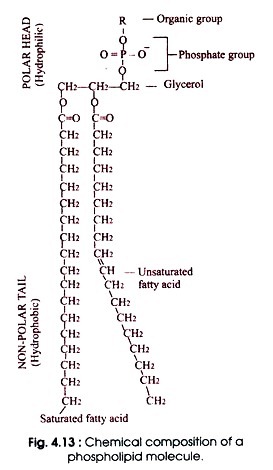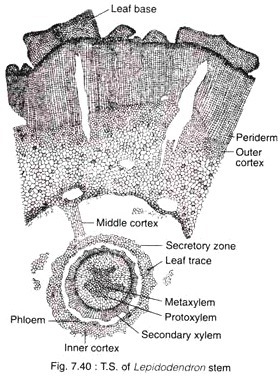ADVERTISEMENTS:
In this article we will discuss about:- 1. Meaning of Plasma Membrane 2. The Fluid Mosaic Model of Plasma Membrane 3. Function.
Meaning of Plasma Membrane:
The plasma membrane also called cell membrane or cytoplasmic membrane is a structure internal to the cell wall. The term plasma membrane was coined by C. Nugeli and C. Cramer in 1855. However, no cell could be alive without a plasma membrane.
It is situated just beneath the cell wall and is 7.5 nm thick. It consists of proteins (20-70%), lipids (28-80%), oligosaccharides (1- 5%) and water (20%). The plasma membrane consists of a continuous bilayer of phospholipid molecules in which globular proteins are embedded.
The Fluid Mosaic Model of Plasma Membrane:
ADVERTISEMENTS:
Singer and Nicolson (1972) have given the fluid mosaic model of plasma membrane to explain its major features (Fig. 4.12). This model is well accepted. According to this model, the plasma membrane is quasifluid structure in which lipids and proteins are arranged in a mosaic manner.
The globular proteins are of two types: extrinsic (peripheral) proteins and intrinsic (integral) proteins. The extrinsic protein is soluble and, therefore, dissociates from the membrane, while the intrinsic protein is insoluble and could not (or rarely) dissociate. The intrinsic proteins are partially embedded either on outer surface or on inner surface of the bilayer and take part in lateral diffusion in lipid bilayer.
Fig. 4.12 : Fluid mosaic model of bacterial membrane.
ADVERTISEMENTS:
The lipid matrix of membrane has fluidity that permits the membrane components to move laterally. The membrane fluidity is due to the hydrophobic interactions of lipids and proteins. The fluidity is important for a number of membrane functions. Phospholipids and many intrinsic proteins are amphipatic i.e. they possess both hydrophilic and hydrophobic groups.
Phospholipids are the complex lipids which are made up of glycerol, two fatty acids and, in place of a third fatty acid, a phosphate group bounded to one of several organic groups (Fig. 4.13). They have polar (hydrophilic) as well as non-polar (hydrophobic) regions. Polar portion consists of a phosphate group and glycerol, while non-polar portion consists of fatty acids.
All non-polar parts of phospholipid make contact only with the non-polar portion of the neighbouring molecules. The polar portion occurs towards outside. This characteristic feature gives the appearance of bilayer. However, between the fatty acid chains proper spacing is maintained by interspersing unsaturated chains throughout the membrane. This type of arrangement maintains the semi-fluidity of plasma membrane.
The presence of complex lipids becomes a key character of certain microorganisms on the basis of which they can be identified. For example, the cell wall of Mycobacterium contains high amount of lipids such as waxes and glycolipids which gives the bacterium a distinctive staining characteristic.
In some microorganisms such as mycoplasmas and fungi, sterols are found to be associated within the plasma membrane (Fig.4.14). Sterols are structurally different from the lipids. The -OH group in cholesterol makes it a sterol. Sterols are alcohols composed of hydrocarbon rings attached to hydrocarbon chain.
The sterols separate the fatty acid chains and check packing which harden the plasma membrane at low temperature. In case of certain bacteria hopanoids are present which have similar role to that of sterols found in certain fungi. These hopanoids do not require oxidation step for their biosynthesis, therefore due to lack of oxygen, anaerobic bacteria also contain hopanoids.
Function of Plasma Membrane:
The cytoplasmic membrane is the site of many metabolic activities as given below:
ADVERTISEMENTS:
(a) The organic and inorganic nutrients are transported by permeases through plasma membrane.
(b) It consists of enzymes of biosynthetic pathways that synthesize different components of the cell wall such as peptidoglycan, teichoic acids, polysaccharides, lipopolysaccharides and phospholipids.
(c) It possesses the attachment sites for bacterial chromosome and plasmid DNA.
(d) The inner membrane invaginates to form mesosomes, a site for respiratory activity. The plasma membrane contains about 200 respiratory proteins that have been found to be anchored for the transport of H+ ions.
ADVERTISEMENTS:
(e) It provides permeability barrier and thus prevents the escape of cellular materials outside the cell, and facilitate the selective entry of organic and inorganic substances inside. Hence, the plasma membranes show selective permeability.



